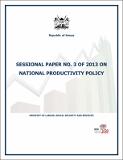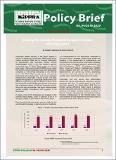Policy Brief No. 34 of 2023/2024 on Assessing Labour Productivity for Bungoma County
Publication Date
2024Author
Naeku, Cecilia & Irungu, Esther
Type
KIPPRA PublicationsItem Usage Stats
44
views
views
6
downloads
downloads
Metadata
Show full item recordBy
Naeku, Cecilia & Irungu, Esther
Abstract/
Bungoma County is a member of the Lake Region Economic Bloc (LREB). The county is a non-ASAL county that experiences less than 10 per cent aridity levels. The county land size stands at 2,207 km² and has twelve Sub-Counties, namely: Bumula, Bungoma Central, Bungoma East, Bungoma North, Bungoma South, Cheptais, Kimilili, Mt Elgon, Bungoma West, Tongaren, Webuye West, and Mt Elgon Forest...........
Subject/
Labour Productivity; Nutrition Sensitive Programmes; Economic Performance; Livestock Production; Basic Education
Publisher
The Kenya Institute for Public Policy Research and Analysis (KIPPRA)Series
Policy Brief;No. 34/2023-2024Collections
Related items
Showing items related by title, author, creator and subject.
-
Sessional Paper No. 03 of 2013 on National Productivity Policy
Ministry of Labour, Social Security and Services (Ministry of Labour, Social Security and Services, 2013)This Sessional Paper on National Productivity Policy presents the paradigm shift required for productivity management in the country. It contains specific and targeted interventions, which when effectively implemented, ... -
Garissa County Fiscal strategy Paper 2020
County Government of Garissa (County Government of Garissa, 2020)The Garissa County Fiscal Strategy Paper (CFSP) 2020 was prepared in accordance with section 117(1) of the Public Finance Management Act, 2012, which stipulates that the County Treasury shall prepare the Fiscal Strategy ... -
Policy Brief No. 94 of 2019-2020 on Closing the Gender Productivity Gap in Kenya's Informal Sector
Agwaya, Rodgers & Mairura, Shelvin (The Kenya Institute for Public Policy Research and Analysis (KIPPRA), 2019)Advancing gender equality in the labour market is critical to enhancing productivity. Historically, labour market structures have led to unequal distribution of opportunities and resources, leaving women disadvantaged, ...



